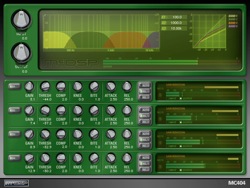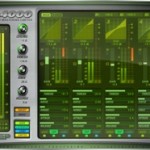
Deadly Bands of Destruction: Part 2

McDSP MC2000
This time out I’m going to get into a specific application for multiband compressors in mixing, but I want to start this by revisiting a quote from Bob Katz about the multiband compressor:
Multiband compression is probably the most powerful and potentially deadly audio process that’s ever been invented….Multiband compression has been overused, and hyped in my opinion. It can easily produce very unmusical sound or take a mix where it doesn’t want to be. This tool requires careful judgment on the part of the mastering engineer.
Bob Katz – Mastering Audio: the art and the science
When it comes to mixing, the multiband compressor can be employed in a couple of functions. It can be great as a way to master mixes for feeds to hallways, CD’s, and video. Some FOH engineers even like to use them on their master buss. However, the popular thing these days is to apply multibands to specific inputs in an attempt to dynamically EQ those inputs, and that’s going to be my focus today.
So why would anyone want to dynamically EQ an input? Well, let’s say we get a singer dialed in, and it’s just money. But when we hit the chorus there is suddenly a note in the upper-midrange of the voice that is jumping out at us in an uncomfortable way. When we EQ that tone out, everything might be fine in the chorus, however, we find clarity takes a hit through the rest of the song. In the studio we might opt to automate an EQ or split a vocal across multiple tracks to process sections of the song differently. However, live sound doesn’t give us the predictability and single song focus of the studio so we typically have to try different tactics to make our inputs work for an entire set.
Traditionally, we might try and find a compromise with our EQ settings by splitting the difference on the cut in the upper-mids and perhaps trying to add some warmth in the low-mids. Our vocal would then work better through the whole song and hopefully the entire set, but in the process we might be losing that something special we had before we heard that chorus. In a case like this, a multiband compressor may be employed by adjusting one of the bands to focus in on the area of the voice that is uncomfortable and attenuate it when the level of that frequency gets to be too much. Then when our singer is back in the verse, the compressor let’s go. Now our great vocal is retained throughout the entire song.
This can be a powerful technique, however, there are some definite dangers in this that result from essentially two major multiband mixing pitfalls that I’ve experienced personally and see other engineers falling into:
1.) The multiband is used too early in the mixing process
2.) The mixer lays into the multiband too much
So let’s look closer at these. The multiband compressor was designed and intentioned to be used in the mastering process. In other words, it’s supposed to be one of the LAST things used in the process. However, I see a lot of guys who turn these on very early in the mixing process. I’ll admit that I know some guys who are very successful when employing them early, but these engineers also tend to have a lot of experience working with multibands, know their sources well, and know where they’re going with all the processing they use. What I’m talking about are guys who essentially ignore the input EQ and go right to the multiband for their EQ needs.
Employing a multiband too early in the mixing process may also lead to the second major pitfall where engineers lay in to the multiband too much. Overuse of the multiband can happen at any stage in the mixing process, however, falling into the first pitfall makes the second easier. It has been my experience that multibands are best used in moderation. When engineers really lay into the multiband too soon and too much, they often end up with all the bands compressing too much. And with all those bands heavily compressed, the engineer often finds himself in the same predicament we can get when we overuse EQ and essentially create full broadband signal attenuation which can lead into chasing our tail and processing more and more. Whereas overuse of too many EQ bands mainly results in gain loss, overcompression can induce awful, unnatural compression side effects that become even more audible as the engineer turns up the overall signal level to compensate for gain loss.
I notice this issue the most when the upper-mid’s and highs become overcompressed on a vocal often in an attempt to reduce sibilance. Sibilance is a pet peeve of mine, but it can be very easy to overdo reducing this. The result is squashed sounding esses and an unnatural sounding vocal. The difficult thing in using the multiband on a vocal or any instrument for that matter, is that when things start to sound weird it can be difficult for novice users to pinpoint which band is creating the weirdness.
I think a lot of the problems guys run into with a multiband come from trying to approach them like an EQ. Always remember something, multiband compressors are NOT dynamic EQ’s, they are compressors. Remember, compressors RAISE the average signal level of a sound, for better or worse. The device might be attenuating, but the net result is decreased dynamic range and a higher average signal level. In a multiband compressor, the average signal level of each BAND is raised when we compress it.
So at this point you might be wondering what the difference is between a multiband compressor and a dynamic EQ. Honestly, not much. A dynamic EQ typically employs peaking filters much like we’d find on our input EQ; think of a dynamic EQ like having a parametric EQ with dynamic gain knobs. The multiband compressor, on the other hand, affects the entire frequency spectrum of the signal using adjustable crossovers to divide the signal into bands for individual processing. It’s a little bit semantic, but hang with me.
So let’s say you’ve got a vocal with occasional problems at 2.5k, sibilance at 8k, and some weird muddy stuff from time to time down around 250 Hz. A dynamic EQ would allow us to notch those frequencies. We can pinpoint them and finely dial things in. With a multiband, we are forced to adjust crossover points to tackle each frequency with a different band. The result with the multiband is we find ourselves with wider filters that also respond to other frequencies within each band, and our multiband often ends up compressing the entire signal more than we realized. Properly setting the crossover points on the multiband is also critical because splitting the signal in odd places and then compressing each band differently can also induce new levels of weirdness on a sound.
In my experience, I’ve found only one true dynamic EQ and that’s the Rane C4(hardware) or the Serato Rane Dynamics(plugin). The thing that makes this unique is it uses a dynamic threshold, and the Rane does this by comparing the level of the frequency you want to filter against the overall signal content so your EQ isn’t dependent on how loud the signal is. In this way, the Rane does a much better job at dealing with frequencies that pop out at you from time to time than a multiband compressor or a traditional level threshold dependent dynamic EQ such as the BSS901.
Unfortunately, the Rane C4 and Serato Dynamics plugin offer only a single filter of processing, and in my experience it seems like there’s always a second frequency you want to touch up a bit when you start getting into this sort of thing. First you go after sibilance, then you want to go after low-mid junk when the singer is singing softer and lower in their register on the third song, or maybe there’s some upper-mid stuff jumping out in a section on the second song in the set. Regardless of what it is that drives me to want to dynamically EQ something, the reality is it’s typically not just one thing which points me back to the multiband compressor.
While a multiband compressor might not exclusively be a dynamic EQ, the good news is that by compressing a frequency band we can smooth/level that individual band out which can give us the perception of dynamic EQ. Furthermore, by properly dialing in each band, we can also use the multiband as an input compressor as well. In a sense, the multiband compressor actually offers us opportunities to kill two birds with one stone: channel compression and dynamic input EQ. But please don’t confuse multiband compression as simply an EQ.
In the next and last post in this series, I’ll look at some of the specific multibands I’ve used and ways I’ve made them work best for me.

 Previous Post
Previous Post Next Post
Next Post


